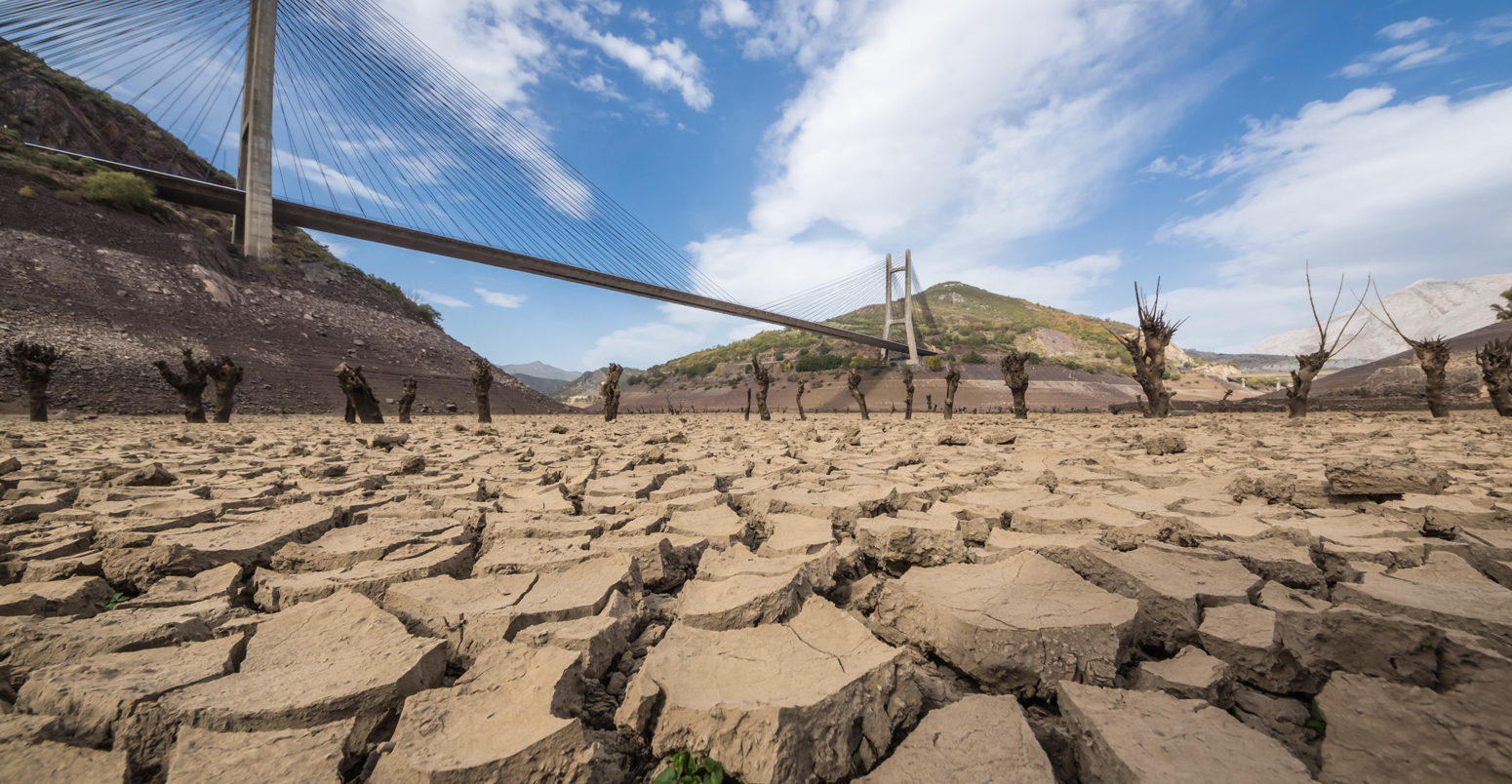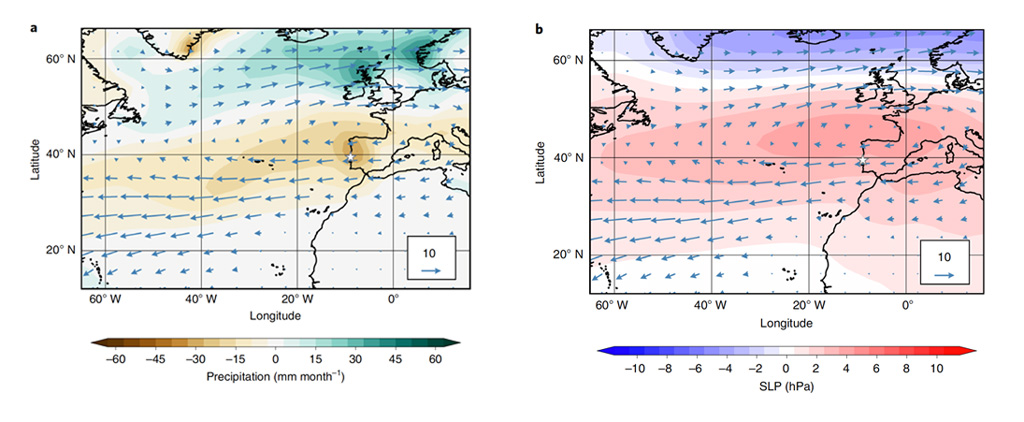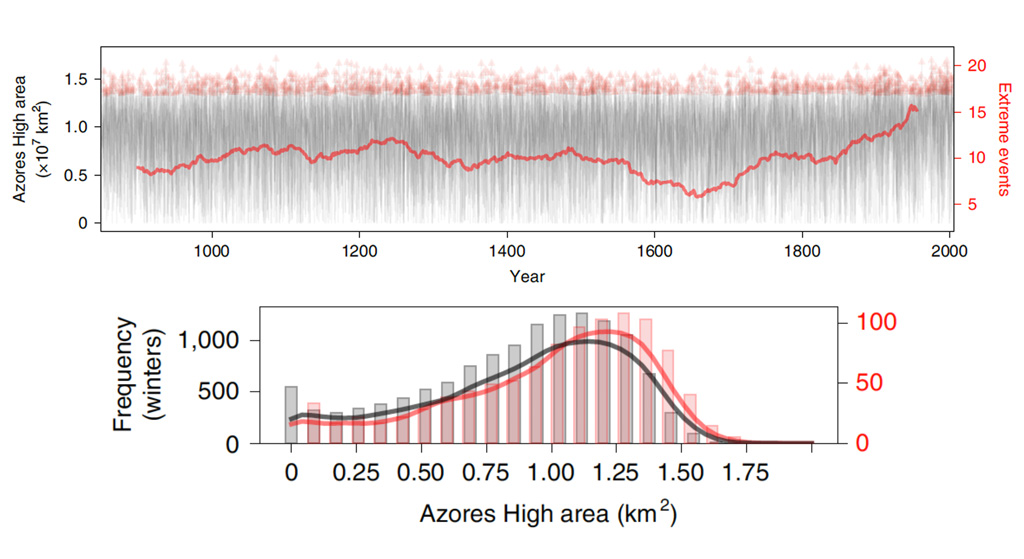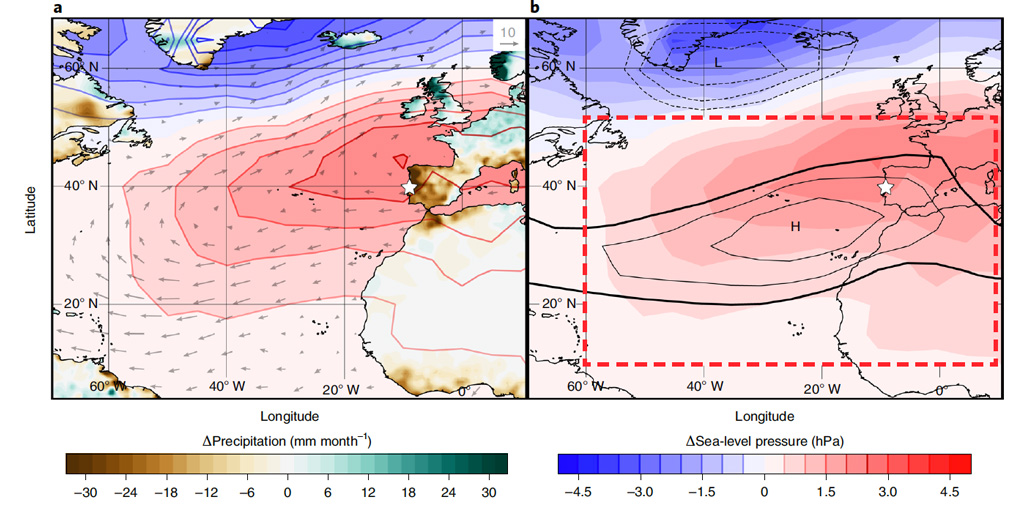
Expanding ‘Azores high’ driving ‘unprecedented’ changes in western Europe’s climate
Ayesha Tandon
07.04.22Ayesha Tandon
04.07.2022 | 4:00pmExpansion of the “Azores high” – a high pressure system in the north Atlantic – is driving “unprecedented” changes in western Europe’s climate, new research suggests.
The study, published in Nature Geoscience, pulls together observations, model simulations and palaeoclimate data to analyse changes in the north Atlantic climate over the past 1,200 years. The authors find that the Azores high – which they call a “gatekeeper” for European rainfall – has expanded as the planet has warmed.
Winters with an “extremely large” Azores high are linked to drier winter conditions across the Mediterranean and wetter weather in the UK. These extremes have become more frequent since the industrial revolution – increasing from one extreme winter every 10 years in the pre-industrial period to one every four years in the 21st century, the study finds.
As the Azores High continues to expand, drying will intensify in Spain and Portugal. The region will see a 10-20% drop in winter rainfall over the coming century – making agriculture of the region “some of the most vulnerable in Europe” – the authors warn.
The study describes the expansion of the Azores high “unprecedented in the past 1,200 years”. However, a scientist not involved in the research tells Carbon Brief that not all the climate models used in the study support this conclusion.
‘Gatekeeper of precipitation’
Europe encompasses a range of climates. Much of the continent – including the UK and much of mainland Europe – is characterised by moderate temperatures and wet conditions all year round. Meanwhile, southern Europe has a Mediterranean climate of hot, dry summers and cool, wet winters.
However, in recent decades, these climates have seen a shift. Winter rainfall over the western Mediterranean has decreased in recent decades by 5-10 mm per year, the study says. By 2100, a further 10–20% drop in winter rainfall is expected – with severe implications for agriculture in countries including Spain and Portugal. Meanwhile, the UK is seeing wetter winters.
To explore the reason for the recent changes in western European rainfall, the authors of the study focus on the Azores high – an area of high pressure in the North Atlantic named after the Azores archipelago west of Portugal.
Formed by dry air descending in the subtropics, the Azores high causes winds to flow clockwise around northern Africa, the eastern coast of the US and western Europe. Westerly winds travelling across the North Atlantic pick up moisture, and draw it over Europe, where it falls as rain.
The size and intensity of the Azores high shifts year on year, driving variations in rainfall levels over the continent. As such, the study refers to the system as a “gatekeeper of precipitation” over Europe.
Dr Caroline Ummenhofer – a physical oceanographer at the Woods Hole Oceanographic Institution in the US – is an author on the study. She tells Carbon Brief that the Azores high is “a really important climate feature in the North Atlantic”, adding that a large Azores high “pushes wind and rain bearing weather systems further north”, causing drying over Spain and Portugal and wetter conditions over the UK.
To determine historical changes in the Azores high, the authors compare sea level pressure – the air pressure at sea level – across the North Atlantic in a given winter to the long-term average. If sea level pressure is above a certain threshold, the authors define the Azores high event as “extreme”.
To demonstrate how the Azores high can impact north Atlantic climate, the authors simulate rainfall and sea level pressure in a winter with an “extreme” Azores high using a group of models called the “last millennium ensemble”.
The plots below show rainfall (left) and sea level pressure (right) during a winter with an “extremely large” Azores high. The green shading shows greater rainfall over the UK, while the brown shading shows lower rainfall over Portugal and Spain. The red and blue shading show high and low sea level pressure, respectively, and the arrows show the direction of moisture transport.

The authors find that an “extreme” Azores high event brings around 35.3 mm per month less rainfall to the western coast of the Iberian Peninsula – a reduction of around one third.
‘Unprecedented expansion’
The authors investigate how the Azores high has changed over the past millennium by combining three lines of evidence. They use climate models to simulate changes in climatic conditions since the year 850, and observations of sea level pressure and rainfall to determine the climate in recent decades.
To verify rainfall levels a millennium ago – before observed data was collected – the authors turn to palaeoclimate data taken from stalagmites in Buraca Gloriosa cave in Portugal. Stalagmites are formed over long periods of time from the build up of mineral deposits – primarily calcium carbonate – carried by groundwater percolating through the rock.

Ummenhofer tells Carbon Brief that stalagmite carbonate chemistry varies depending on environmental conditions, so scientists can look at the carbon isotope record along the length of the stalagmite to determine historical rainfall levels. She adds that “fortunately”, the Buraca Gloriosa cave is “located right in the bullseye of where the Azores high drying is experienced”.
The authors find that the three lines of evidence agree well with one another on past changes in the north Atlantic.
The plots below show changes in the frequency (top) and area (bottom) of the Azores high over the past millennium. In the top plot, the red line shows the number of winters with an extreme Azores high, measured over a 100-year window. Individual model runs are shown in grey, and individual extreme events are shown with triangles. In the bottom plot, the grey bars show the size of the Azores high in the pre-industrial (grey) and industrial (red) eras. The larger the bars to the right of the plot indicates a greater frequency of Azores high systems with a large area.

The authors find that the size and the number of “extreme” winter Azores highs has “increased significantly”, from one every 10 years in the pre-industrial period to one every four years in the 21st century.
The title of the study describes this expansion of the Azores high “unprecedented in the past 1,200 years”. However, Dr Jacob Scheff – an assistant professor at the University of North Carolina, Charlotte, who was not involved in the study – questions this statement:
“While this study is of considerable interest, it does not actually show that the real-world Azores high expansion is unprecedented in the last 1,200 years. Instead, it shows that in one particular climate model, the expansion is unprecedented in the last 1,200 years in most simulations.”
As not all models used in the study support this conclusion, Scheff warns that “the title statement is not justified by the study”.
The authors also explore changes in the Azores high since 1950 by using observations of sea level pressure and rainfall to compare its average size in 1950-79 and 1980-2007. This is shown in the maps below.
Brown shading indicates a decrease in rainfall over time, while green indicates an increase. Blue and red represent decreasing and increasing sea level pressure, respectively. The dashed box shows the area considered in this study. The star shows the site of the Buraca Gloriosa cave. “H” and “L” correspond to two pressure systems over the Atlantic Ocean – the Azores high and “Icelandic low” – an area of low pressure located between Iceland and southern Greenland.

Winter rainfall over western Mediterranean has decreased in recent decades by 5-10mm per year, the plot shows. Meanwhile, the UK has seen a trend of increasing rainfall.
Attribution of the Azores high expansion
Finally, the authors investigate what caused the Azores high to expand. They use climate models to simulate how many extreme Azores high events would have occurred over the past 1,200 years under a range of different climate conditions.
The plot below shows the different drivers tested. The green line shows model runs that only consider changes in greenhouse gas emissions, red shows only changes in volcanic activity, yellow shows only changes in solar activity and black shows all three.

The plot shows that an increase in extreme Azores high events over the past 100 years is best captured by the model when greenhouse gas emissions are included.
Dr Justin Mankin – an assistant professor in the department of Geography at the University of Dartmouth, who was not involved in the study – tells Carbon Brief that “the paper is interesting and the authors clearly did a lot of nice analysis on the footprint of the Azores high”.
However, he adds that changes in the size and intensity of the Azores high could also have been driven by changes in aerosol levels, rather than changes in greenhouse gases emissions. (For example, the passing of the US Clean Air Act in the 1970s saw pollution levels drop significantly, causing localised warming.) That the authors did not investigate this factor is “a curious omission” he says.
The study suggests that the Azores high expansion is linked to changes in the Hadley circulation – a major atmospheric circulation system which cycles air between the equator and the mid-latitudes. The video below explains the Hadley circulation, and the other “cells” in the Earth’s atmosphere that move heat from the equator to the poles.
As the climate warms, the Walker and Hadley circulations are weakening and widening, reducing the mixing of air across different altitudes and drying the atmosphere. Research published last week linked the weakening of these circulations to a reduction in the number of tropical cyclones worldwide.
Ummenhofer tells Carbon Brief that “changes towards more frequent large wintertime Azores high situations are consistent with a widening of the Hadley Circulation in a warming climate”.
Prof Richard Seagar – a research professor at Columbia University, who was also not involved in the study, tells Carbon Brief that the expansion in the Azores high could also “easily be explained by the long-term variability and changes of the North Atlantic Oscillation”.
The North Atlantic Oscillation (NAO) is one of the most significant drivers of natural variability in the Atlantic, and is driven by the pressure difference between the Azores high and Icelandic low. The video below explains how the NAO influences weather in the UK.
Seagar tells Carbon Brief that it “would be good if [the authors of the study] showed the timeseries of the Azores high size with that of the NAO”, so that changes in the two over time could be compared. He adds that he is “not sure how novel” the findings are.
Meanwhile, Mankin adds that he “struggled with a couple of analytical choices”. He says:
“I think the key questions that arise for me is whether they’ve really sampled variability in the Azores high, and whether they’ve attributed its changes. I think they’ve started that work, but I’m not entirely convinced they’ve done either to the extent that we can be confident in the attribution of the real world.”
Cresswell-Clay et al (2022), Twentieth-century Azores high expansion unprecedented in the past 1,200 years, Nature Geoscience, doi:10.1038/s41561-022-00971-w
-
Expanding ‘Azores high’ driving ‘unprecedented’ changes in western Europe’s climate





